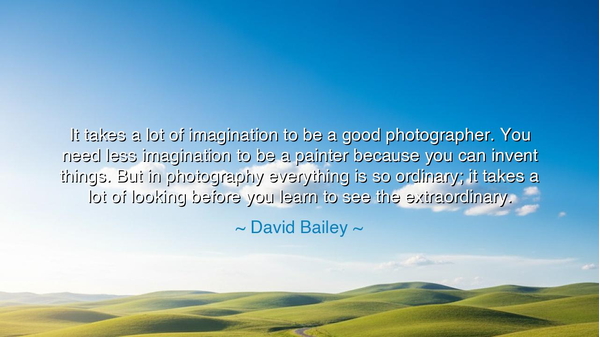
It takes a lot of imagination to be a good photographer. You need
It takes a lot of imagination to be a good photographer. You need less imagination to be a painter because you can invent things. But in photography everything is so ordinary; it takes a lot of looking before you learn to see the extraordinary.






“It takes a lot of imagination to be a good photographer. You need less imagination to be a painter because you can invent things. But in photography everything is so ordinary; it takes a lot of looking before you learn to see the extraordinary.” — thus spoke David Bailey, the rebel visionary who transformed photography from a mechanical craft into an act of revelation. In these words, Bailey unveils a profound truth about perception, imagination, and the hidden splendor of the everyday. He teaches that while a painter may summon beauty from within, the photographer must wrest it from reality itself — from the dust of the streets, the curve of a hand, the flicker of light on a windowpane. His art is not invention, but illumination. To truly see the world as it is — to pierce its veil of ordinariness and behold its secret majesty — demands a courage and creativity that surpass mere invention.
The origin of this quote lies in Bailey’s defiance of convention. Rising from humble beginnings in postwar London, he became one of the most celebrated photographers of the twentieth century — the lens through which the “Swinging Sixties” saw itself. While others sought beauty in grandeur, Bailey found it in truth. He saw elegance in a wrinkle, mystery in a shadow, poetry in the unposed. For him, photography was not about constructing fantasy, but about discovering reality anew. His genius lay not in altering the world, but in seeing it differently.
To understand his meaning, one must first grasp the distinction he draws between painting and photography. The painter begins with a blank canvas and may summon dragons or dreams as he wills; he commands the power to invent. But the photographer begins with a world already made, a reality unyielding and indifferent. His task is to find, within that world, the spark of the miraculous. To capture beauty not by adding to life, but by revealing it. This is the sacred labor Bailey speaks of — the art of vision, of learning to see the extraordinary hidden beneath the familiar.
In this way, Bailey’s philosophy echoes the teachings of the ancients. The Greek philosopher Heraclitus once said, “The unseen harmony is mightier than the seen.” So too does the photographer seek that unseen harmony — the secret order of light, form, and emotion that hides in plain sight. Like a mystic seeking revelation in the mundane, the photographer must look beyond surfaces. He must cultivate a patient and disciplined imagination, one that does not flee from reality but penetrates it. The painter dreams what could be; the photographer dreams what already is, but has yet to be seen.
Consider the example of Dorothea Lange, whose photograph Migrant Mother became the silent voice of a generation. She did not invent her subject — she found her, a weary woman on the roadside, burdened by despair. Yet through Lange’s imagination, through her understanding of light, form, and humanity, that single image became a symbol of resilience and sorrow that transcended its moment. She did not alter the scene; she revealed its soul. This is the essence of Bailey’s teaching: to be a good photographer is to awaken to the world, to find the eternal within the fleeting, the divine within the ordinary.
Bailey’s words also hold a mirror to life itself. For what is living, if not the art of seeing? Most drift through the days blind to wonder, numbed by routine, imprisoned by familiarity. Yet the wise — the artist, the philosopher, the awakened — learn to look deeply. They find beauty in decay, joy in simplicity, and meaning in what others overlook. This is the imagination Bailey speaks of: not the power to invent, but the power to perceive. To see life not as dull repetition, but as a ceaseless unfolding of miracles disguised as ordinary moments.
The lesson, then, is timeless: train your eyes, not merely to look, but to see. Do not hunger only for the marvelous and strange, for the world itself is a gallery of wonders waiting for those who dare to notice. The ordinary is never truly ordinary — it is the veil that conceals infinity. Whether through a lens, a pen, or the quiet gaze of contemplation, let your imagination uncover the sacred hidden in the simple. For to live with such sight is to live artistically, even if you never lift a camera.
Thus, remember the wisdom of David Bailey: it is not invention, but imagination, that makes the artist. And the truest imagination is not an escape from the world — it is a return to it, seeing it as though for the first time. In every shadow, light awaits; in every face, a universe resides. To those who learn to look, the world itself becomes a masterpiece — and every breath, a photograph of the eternal.






AAdministratorAdministrator
Welcome, honored guests. Please leave a comment, we will respond soon